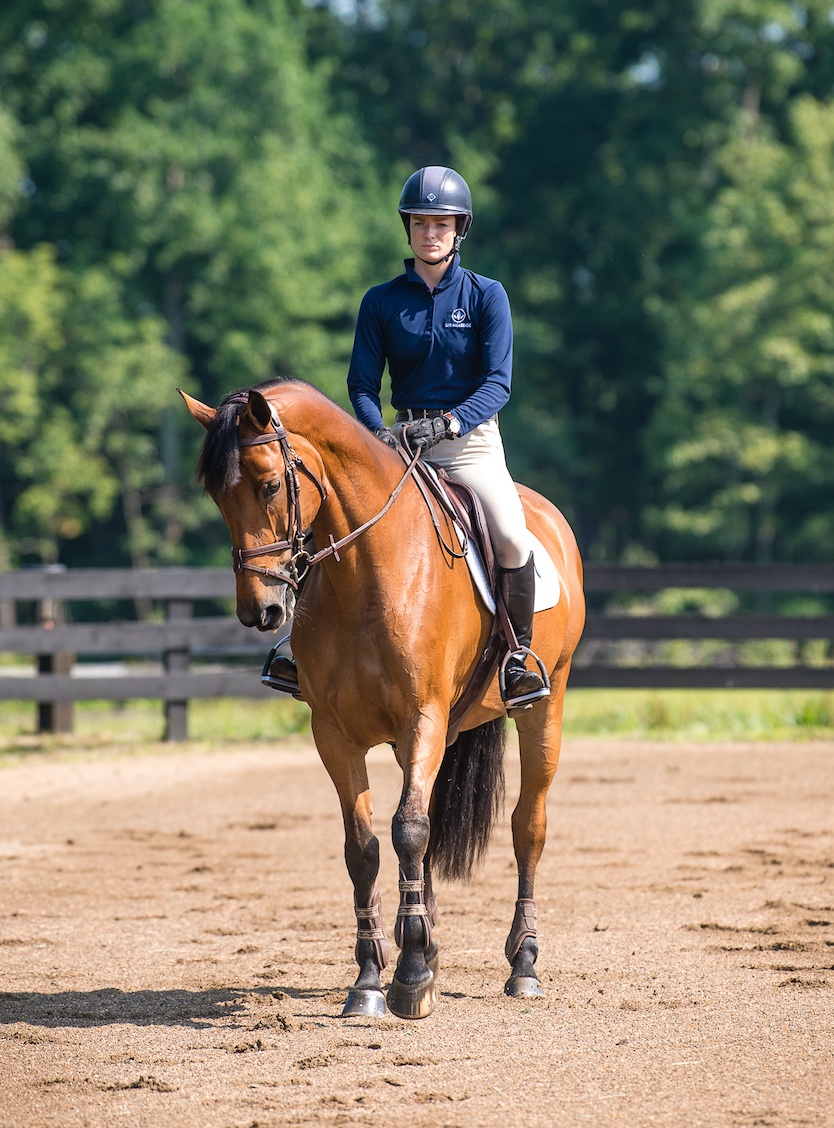
Imagine cantering your horse down to a diagonal fence on the left lead. He jumps the fence nicely, but instead of landing on his right lead, which would set you up perfectly for the upcoming right turn, he lands on his left lead. So you cue him to make a flying change and … nothing happens.
Did you give the wrong aids for the flying change? Actually, that’s the wrong question to ask in this situation. Producing reliable flying changes isn’t just about giving the right aids at the right time. And it’s not about practicing flying changes over and over again. In fact, the solution doesn’t require you to practice a single flying change. It’s all about the setup. Once you’ve learned to recognize the balance your horse needs to be in to pick up the lead you want, and correct that balance when necessary, flying changes will come easily—without you even having to think about your leads.
I’ll teach you these skills with three exercises. Don’t expect them to work instantly. It takes time to develop the feel for how your horse’s weight is balanced and how you might need to shift it. You’ll also discover that each horse’s ideal balance is slightly different. So give yourself time to get to know every mount you ride. The more you focus on these basics, the better your flying changes will be on course.
Understand the Mechanics
Many people learn how to pick up the canter and initiate a flying change by first bending the horse to the inside. Although this can be effective with well-trained horses, I find it more beneficial to teach horses and riders—especially if they’re green—to pick up the correct lead from a counter bend. Young horses and ex-racehorses, who usually don’t know how to bend well to the inside yet, find these transitions and changes mechanically easier if they’re bent to the outside.
Imagine your horse has a weight hanging from each corner of his body: right front, right hind, left front and left hind. To pick up a left-lead canter, he needs to lift the weight on the left front corner. This will allow him to strike out with his left foreleg. Anything you do to interfere with that weight shift—lean your upper body to the left, pull his head to the left, etc.—will make it harder for him to pick up that lead. That’s why the more desperately you push for a lead change, the more likely you are to not get it!
If your horse has a tendency to bulge his shoulder to the left, that, too, makes it more difficult for him to shift his weight correctly. To help him get out of his own way, you need to ask him to shift that weight back toward his outside (right, in this example) hind leg. Turning his head slightly to the outside and moving him from your inside (left) leg to your outside (right) rein will “open up” his inside foreleg, allowing him to pick up the lead. Easier said than done, I know. But the exercises below will help.
Find Your Balance First
First check that you are in the proper position and balance. To avoid interfering with your horse’s balance, you must have your weight down in your heels and be in control of your upper body. Resist the temptation to slap your shoulders down over the jump, look down for the lead in the air or pull on the inside rein. Maintaining your own balance actually takes quite a lot of strength, so I recommend committing to a personal fitness program in addition to your regular riding. Instead of lifting weights, focus on exercises that improve your balance and core strength, like Pilates.
With this core strength, you should be able to relax your body and ride with a loose, following arm. Concentrate on opening your hip angle over the fences and focus on the position of your hips—rather than your shoulders—in the air.
The following exercise will help you find your power position: the position you want to be in for just about everything other than galloping. This is the position you’ll need to be in later for your flying change setup.
Exercise 1: Halt in Balance
Why do it: This exercise will help you find the position you want to be in to ensure your horse is balanced for a flying-change setup. Practice this exercise from the walk first, traveling in a straight line:
• Prepare yourself for a halt transition by sliding your legs slightly forward and pushing your weight into your heels.
• At the same time, tighten your abdominal muscles and open your hip angle, leaning your upper body back just a bit. Imagine you’re preparing to step on the brake in a car. To prevent the car’s momentum from carrying your shoulders forward, you need to sit against it slightly.
• Maintain this position while applying your rein aids to ask for the halt. Keep your weight firmly in your heels to prevent your horse from pulling you forward, especially if he is a little strong in the bridle.
Practice this several times until you start to feel like you can produce the halt with less rein aid than you needed initially. Then try the exercise from the trot. Eventually, work your way up to doing it from the canter. The goal is to practice this power position so much that you can slip into it in a split second.
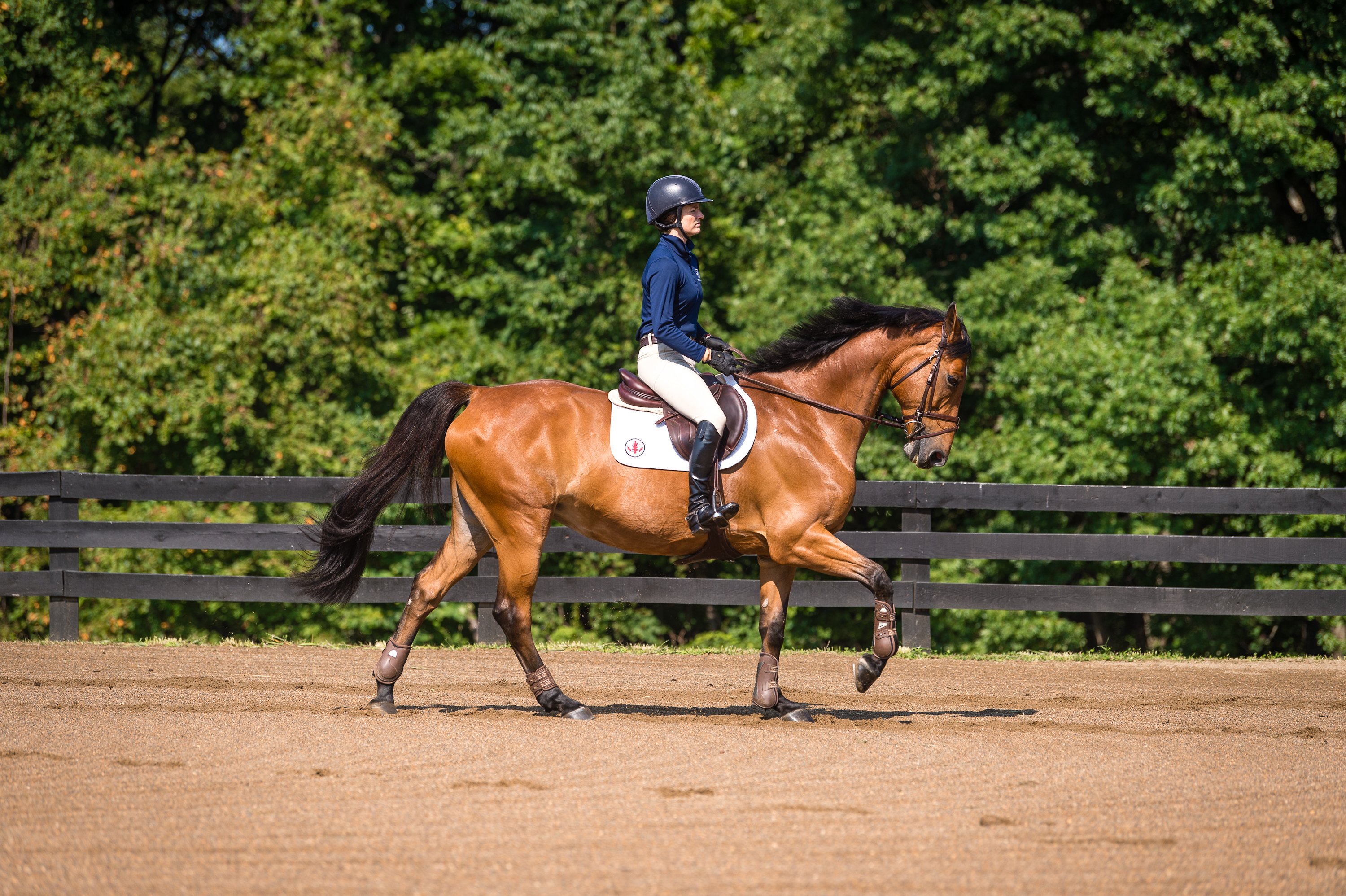
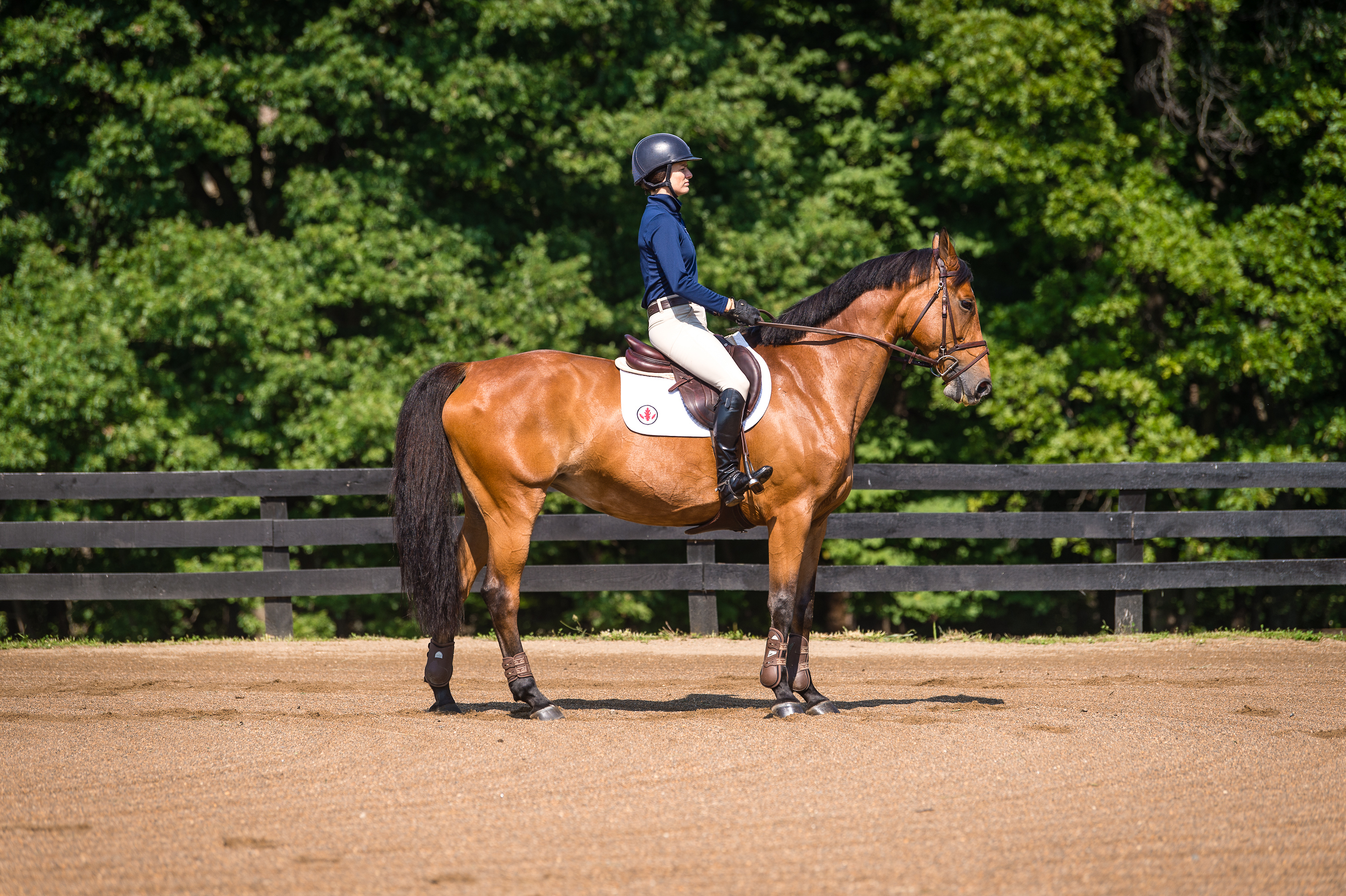
Exercise 2: Walk to Canter on a Slight Angle
Next, let’s review the basic canter aids to help ensure that your horse is in the correct balance to pick up the lead you want, which later will make flying changes come easily. Every horse has a good side and a bad side, so practice this exercise on your horse’s easier lead first to be sure you both understand it. Then try it on his more challenging lead.

Here’s how to pick up the left-lead canter:
• Start by walking down the long side of the arena, at least 2 meters off the rail, with your eyes focused up and ahead.
• To set up for the transition, shift your weight just enough so that you feel your outside (right) seat bone on the saddle more than your inside seat bone, without leaning your upper body in either direction. (Practice this slight weight shift on a firm chair at home first.)
• Slide your outside (right) leg back behind the girth and ask your horse to move his haunches slightly to the inside.
• At the same time, apply your inside (left) leg at the girth to push his shoulders toward the outside.
• Keeping a straight line from your elbow to your hand to the bit, use your outside rein to straighten his neck, bringing his nose a little to the outside.
This will create a mild angle in your horse’s body with his outside (right) hind leg tracking directly behind his inside (left) front leg (see diagram to the right). Be careful to keep him straight through his body, neither bending to the inside nor the outside. Meanwhile, continue walking in a straight line parallel to the rail.
You’ll know your horse is properly set up if you can almost see his outside (right) eye. You’ll also get a sense that his weight is shifted to the outside, opening up space for his inside foreleg to strike off in the canter. Think again of the four weights hanging from his four corners. The heaviest one should be on the outside (right) hind while the lightest is on the inside (left) front. If you don’t feel this balance, push him over more with your inside leg.
The next challenge is to maintain this balance throughout the transition to canter.
• Try to stay very balanced yourself and quiet in your body as you squeeze your outside leg behind the girth to ask for the canter.
• Allow him to canter for several strides before bringing him back to walk and repeating the exercise.
If he picks up the wrong lead, he’s likely throwing his weight onto the inside front leg during the transition. To correct this, prepare him with the slight angle and weight shift to the outside at the walk again, but this time:
• Keeping your eyes up, make a transition to trot. Use a firm inside leg to push his shoulders to the outside during the transition, so he can’t throw his weight to the inside.
• Maintain this balance as you return to walk.
• Repeat these walk–trot transitions several times until you feel like you can control his angle and balance throughout.
• Then try the canter transition again.
When you feel comfortable making walk–canter transitions on your horse’s good lead, repeat the exercise on his other lead. Be aware that you may need an even stronger inside leg to set up for this lead.
Exercise 3: Diagonal Jump, Halt and Circle
This exercise incorporates the skills you practiced in the first two exercises and teaches you and your horse to find the correct balance for making a flying change after a jump. The halt in the exercise will slow his momentum down after the jump, rock his weight off your hands and back onto his hind end and teach him not to anticipate the lead change. All you need is a simple vertical set on a diagonal at a height you’re comfortable jumping.
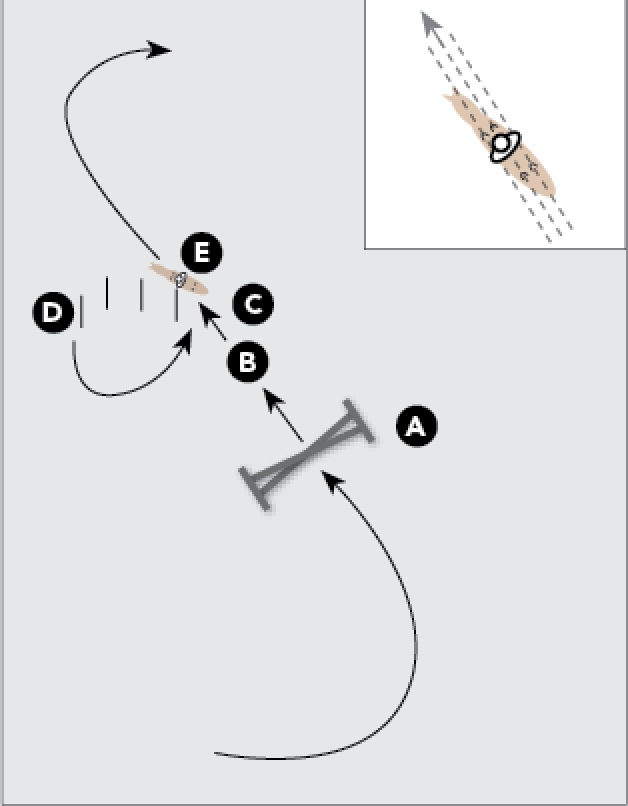
• Canter to the jump on your left lead (for a jump set on a left-lead diagonal, as in the diagram above) concentrating on riding your horse straight on your line and keeping your eyes focused up and ahead of you. Whatever you do, don’t think about what lead you want him to land on.
• After the jump, find the power position you practiced in Exercise 1—dropping your weight into your heels and leaning your shoulders back slightly—and then bring your horse to a halt, still on the straight line of your track.
• Then praise him, walk forward and make a left turn back to the rail.
• Repeat this two or three times until you feel your horse responding well to your downward transition aids and coming to a halt closer to the landing side of the jump.
• If he’s strong in the bridle, ask for a few steps of rein back after each halt. This will encourage him to stay softer in your hands.
Next, add a small walk circle to the left after the halt. How you perform this circle is very important, because it’s going to teach your horse to shift his weight correctly in preparation for the new (right) lead, in the same way you set up for the transition in Exercise 2. Because the eventual goal is to make a flying change to the right lead, your old outside (right) aids now become your new inside aids. Think of how Western riders turn their horses by neck reining as you use these new aids to ask for the small circle to the left:
• Keeping your hands together, move them both to the left so that the right rein comes against your horse’s neck without crossing it. Use your right leg at the girth to push his shoulders around the circle. Feel more weight shifted onto your left seat bone and use your right rein to keep your horse’s neck straight or slightly counter bent (with his nose to the right).
As you complete the circle and return to the straight track you were following after the jump, use the aids you did in Exercise 2 to set his balance up for the right-lead canter:
• Go to your power position first. Then shift your weight slightly onto your outside (left) seat bone, slide your new outside (left) leg back behind the girth to move his haunches to the inside, push his shoulders left with your new (right) inside leg and straighten his neck and bring his nose a little to the outside (left) with your new outside (left) rein. Remember, eyes up!
This should position his body at a mild angle to the track, with his haunches marginally to the inside (right) and his head and neck pointing slightly to the outside. Again, check in with how his balance feels. You want to feel the most weight on his new outside (left) hind leg and the least on his new inside (right) front leg. If you feel this balance, go ahead and ask for a right-lead canter. If you don’t, turn left and repeat the exercise. With enough repetition, your horse will begin to shift his weight automatically in the correct way and will be properly set up for the new lead.
When you’ve mastered this exercise in this direction, try it the other way. Set up a single fence on the other diagonal and canter to it on your right lead, then land, halt and circle right. Proceed through the steps just as you did before, using your power position in the halts, your slight counter-bending aids on the circle and your newfound feel for your horse’s balance. As with Exercise 2, you’ll probably find that you need to use stronger inside-leg-to-outside-rein aids to correct your horse’s balance in one direction than the other.
With practice, you’ll eventually learn to evaluate and correct your horse’s balance immediately after landing from the jump. Then you can simply apply the aids you used in these exercises to set him up for the flying change, without making a downward transition or circle. Add your canter aid—a squeeze of your outside leg behind the girth—to execute it.
Depending on your horse, you may find that practicing the actual flying changes at home is counterproductive. Some horses—especially green or nervous ones—get excited or anxious when working on flying changes. It’s important to know your horse and do what’s right for him. Even if you don’t rehearse the actual flying change, I promise that if you take your time and practice these exercises enough at home, you will ace your flying changes in competition.
ABOUT SLOANE COLES
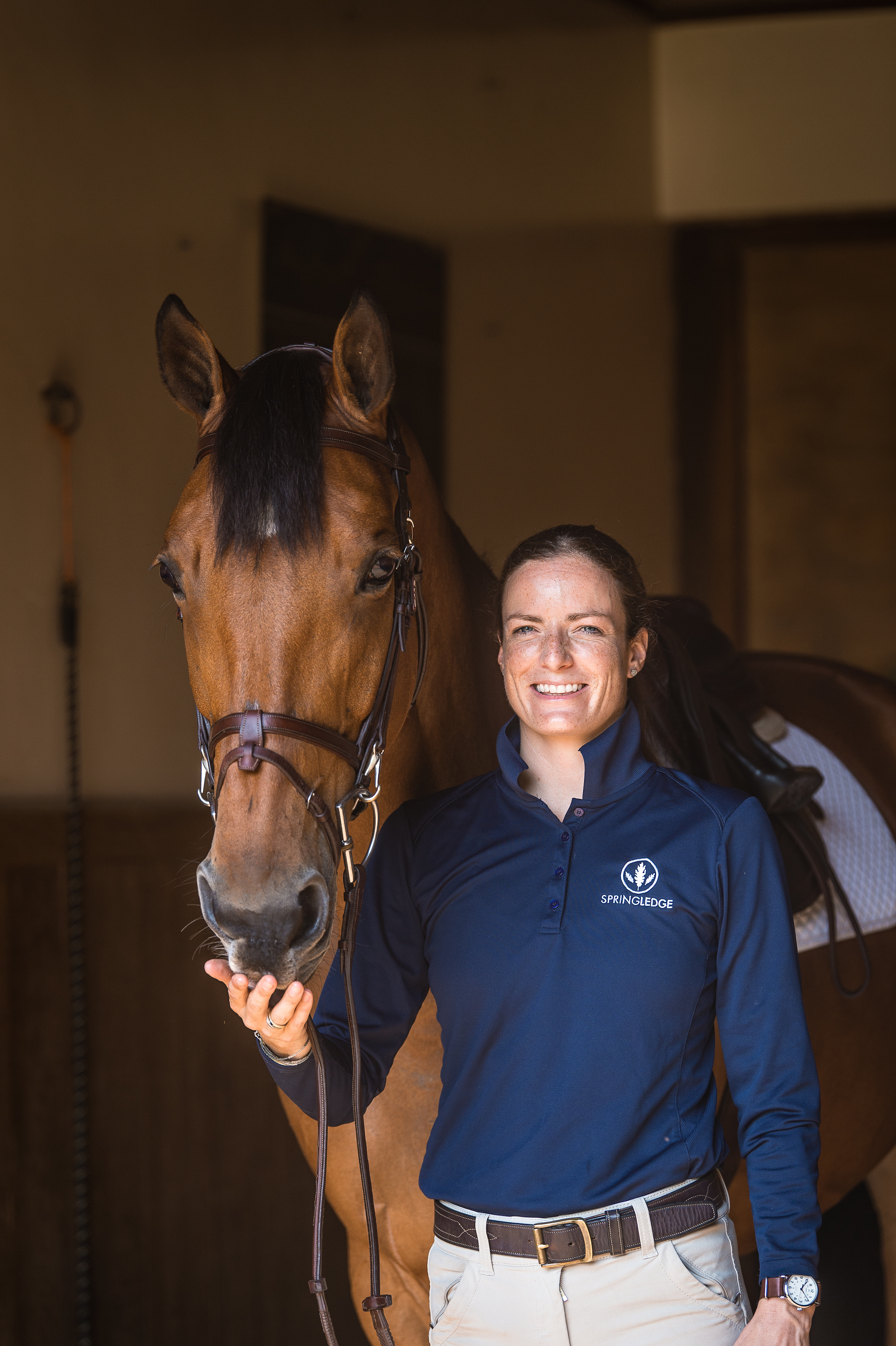
Sloane Coles grew up trail riding and foxhunting in The Plains, Virginia, where her father is a joint-Master of Foxhounds with the Orange County Hunt and her mother foxhunts and shows hunters as an amateur. Under the tutelage of John and Beezie Madden, Johnny and Kitty Barker and the trainers at Beacon Hill Show Stables and Heritage Farm, Coles enjoyed a successful Junior career, earning top placings in all of the national equitation finals, including a win in the 2006 North American Equitation Championship. She also won the 2006 Bates USA Equitation year-end rider award before turning professional. In 2010, she was named to the U.S. Equestrian Federation Developing Rider Show Jumping tour.
While attending Drew University, Coles trained with renowned jumper rider and trainer Mark Leone. After graduating in 2011 with a degree in sociology and business, she decided to expand her horsemanship education by working in Belgium in the sales barn of 1976 Olympic bronze medalist François Mathy (who discovered McLain Ward’s great Olympic partner Sapphire). After riding at least 10 horses a day there and learning all she could about the business side of show jumping, she moved back to The Plains and established Spring Ledge LLC, a sales and training facility for hunters, jumpers, foxhunters and eventers. In 2014, she was invited to the George H. Morris Gladstone Program for international riders. Meanwhile, she continued to compete successfully in the grand prix and hunter rings at major North American competitions.
Some of Coles’ recent winning partners include Autumn Rhythm, with whom she won all three 2014 First-Year Green Hunter Stake classes at Indoors, 2017 $50,000 Grand Prix of Michigan winner Esprit and CSI**** veteran MTF Saint Simeon. She and the latest addition to her grand prix string, Chippendale’s Boy DZ, placed second in the $50,000 Flintfields Farm Grand Prix CSI** at the 2018 Great Lakes Equestrian Festival.
This article was originally published in the Spring 2019 issue of Practical Horseman.










